Boaz Siding
This location was immortalized in a photo by O. Winston Link. It was where pusher engines laid over at the bottom of the Blue Ridge grade on the Norfolk & Western.
I asked at least Norfolk Division enginemen about the pronunciation of the word "Boaz." They all told me the crews had pronounced the word as "bows." The only particular name I can come up with for these memories is that of Engineman D. P. Clark.
-- abram burnett
The Google map image shows the present view of the location. Per messages on the N&W Historical Society list (posted by Jeff Hawkins and Ron Davis) the area now known as "Berkley Bottom" was the location of Boaz Siding. Jeff notes, "Best I can recall from previous research is that the switch was located atop the culvert with the siding extending to the west alongside the eastbound mainline. That would place the "Honey Hole" per Link's photo somewhere near the end of the gravel parking lot." Ron added directions to the location, "Take US460 East out of Roanoke to King Street. Turn right then follow King Street about 3/4 mile to Berkley Road on the left. Follow Berkley Road across the tracks then take an immediate left onto a gravel road. This will lead into the soccer fields of Vinyard Park."
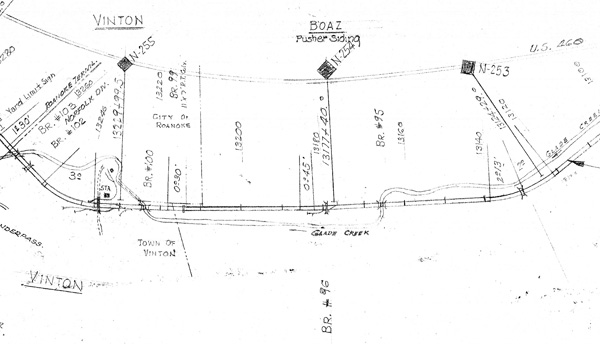
This section of track chart shows the siding coming off on "Bridge 96" just west of MP N-254. (click on the image to load a larger image.)
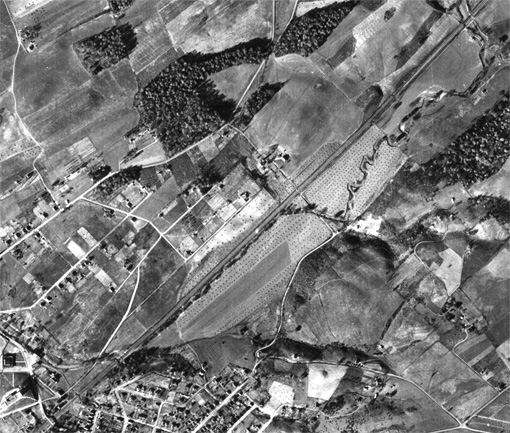
(click on the image for a larger view)
This section of a November 23, 1937, aerial photo of the Roanoke area shows the location of Boaz siding, but even enlarged it is difficult to see if there was a siding there. The Vinton station is in the lower-left corner of the image. There is also a larger 1.3Mb image for those with a fast connection:
Boaz-1937.jpg.
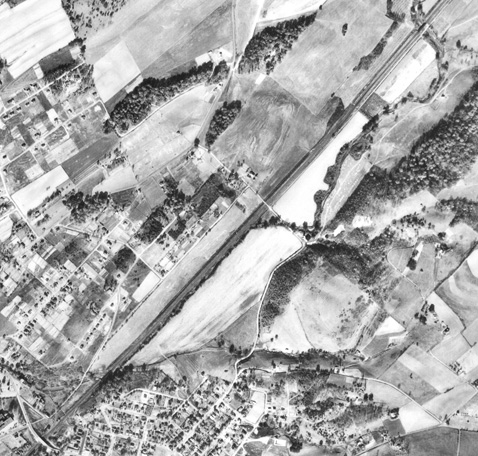
(click on the image for a larger view)
This section of a November 2, 1953, aerial photo of the Roanoke area shows the location of Boaz siding, and it appears there is a siding there. The Vinton station is in the lower-left corner of the image. There is also a larger 1.5Mb image for those with a fast connection:
Boaz-1953.jpg.
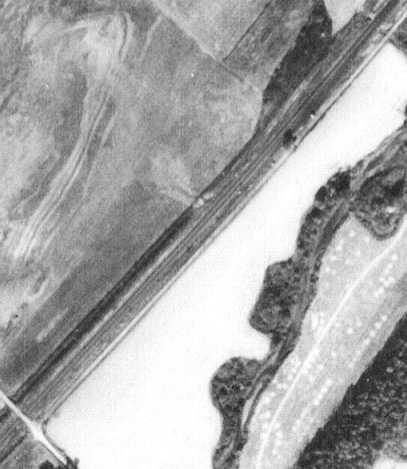
This enlarged view appears to show a steam engine sitting in the siding. The Berkley Road crossing and the stream to the east are shown for reference.
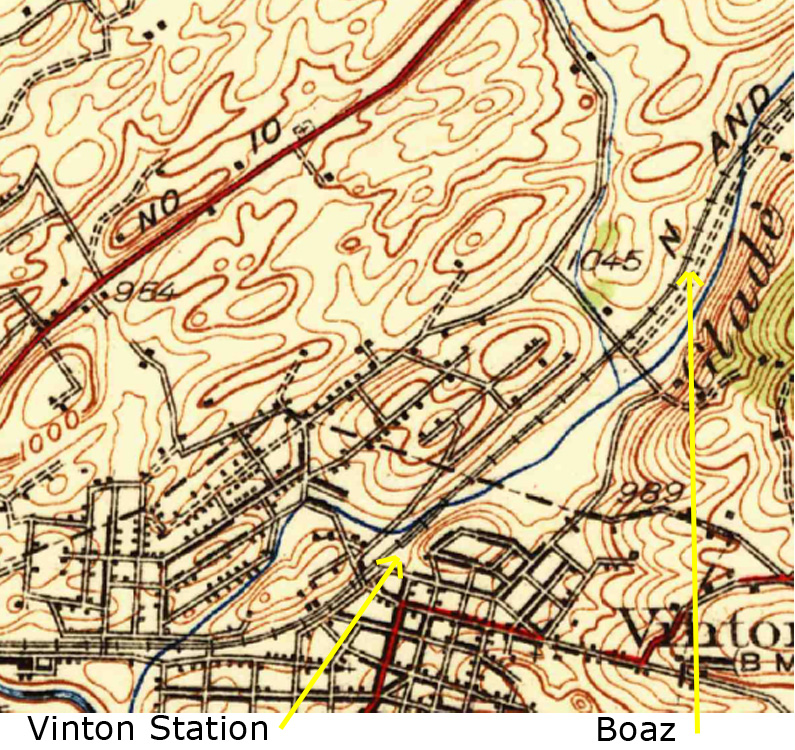
This section of a 1933 topo map of Roanoke shows the Vinton station siding further east, close to where today's Gus Nicks Blvd. crosses the tracks on an overpass. Missing is the pusher siding.
Here is a photo taken of a meet at the Vinyard Park location on October 29, 2005, from the soccer field parking lot. The Google map shows that there isn't much room there and the photo shows a steep embankment close to the tracks.
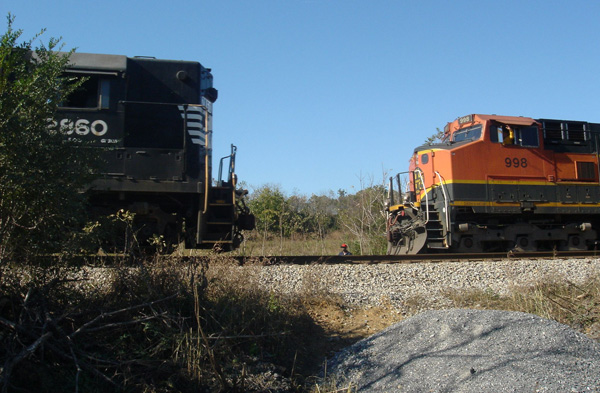
(Click on the photo for a larger image).
Operations
(From the N&W mailing list discussion:)
This discussion makes one wonder how the pusher service worked. Did the pusher crew know what trains were coming or just push everything that showed up? Did they use telephone? or radio? How does the road crew know where to stop a 2-mile-long train to clear the switch at the pusher siding? How many trips up the hill could a Y6 make before refueling? How long was the pusher crew's day? What did they do between trains? How much further from Roanoke terminal was the East side pusher?
Ted Goodman
Blue Ridge pusher crews were based in Roanoke and used Y-6 locomotives. They normally worked approximately 8-hour shifts, depending on timing of the trains to be pushed. They normally received their instructions from the Norfolk Division dispatchers by phone from the pusher siding at Boaz and, when necessary, from other points along the line. They normally pushed all coal trains, which generally consisted of about 100 cars weighing a total of about 8,200 tons, as well as most time freights, weighing about 6,500 tons.
Coal trains consumed about 40 minutes being pushed from Boaz, MP N-254, at an elevation of 933 feet, to the summit of Blue Ridge near the west end of Villamont middle track, MP N-254.5, at an elevation of 1,296 feet. Time freights consumed less time, usually about 30 minutes. After the pusher cut off at the summit, a member of the crew would talk to the dispatcher by phone and receive further instructions. Usually they would return to Boaz and wait for the next eastbound train, but occasionally they would be instructed to go to Montvale (MP N-241) and push a heavy tonnage westbound train.
Depending on the flow of traffic, they would push about 4 trains per tour of duty.
There were no 2-mile long trains on that section of the Norfolk Division at that time. Most of them were about a mile long. The crews knew from experience where to stop to pick up the pusher, and if they had tried to go much farther they would have stalled on the steepening grade without the pusher.
Some details about the operation on Blue Ridge in the mid-1950's, when "Jawn Henry" was being used in pusher service, can be found in my book Rails Remembered, Volume 4.
Louis Newton
There was a similar siding on the other side of the mountains at Irving for Westbound trains.
Ron Davis
Here's another question about pusher operations over Blue Ridge. If a helper was required on the head end, was it placed on the train prior to leaving Roanoke or was it added at Boaz? Where was the head end helper removed?
Jeff Hawkins
Eastbound coal trains over Blue Ridge normally had a Class A engine next to the train and a Class Y6 helper in the lead, both added in the West Yard at Roanoke. I think the Y6 was normally removed at Phoebe and the Class A took the train on to Crewe.
When I worked in the Shaffers Crossing roundhouse in steam days I could see this order of engines on the head end of a coal train passing the roundhouse even if the clues to their classes were hidden by a string of hopper cars between the engines and the roundhouse. This was because the exhaust from the Class A smokestack went straight up whereas the exhaust from the Class Y6 was angled forward because of the angled nozzle and stack needed to clear the superheater/front-end throttle in the short smokebox on those engines. Both engines were working hard to accelerate their heavy coal train as they passed the roundhouse, so there was plenty of exhaust to see.
Gordon Hamilton
Anyone know when the spur was taken out of service? Did it ever see diesel pushers or were they put on in Roanoke? The timing would have to depend on the end of steam and EB tonnage being diverted to the VGN side (crossover installs at Kellysville or Tinker Creek and Abilene)(?).
Grant Carpenter
I'd venture a guess that Boaz siding was removed shortly after the 1959 acquisition of the Virginian. At that point there was no need for the N&W to operate loaded coal trains over Blue Ridge Grade since they could now utilize the former Virginian mainline east of Roanoke with the new (at the time) connection at Abilene.
To the best of my knowledge, Tinker Creek Connection was also constructed immediately following the N&W/VGN merger.
Jeff Hawkins
